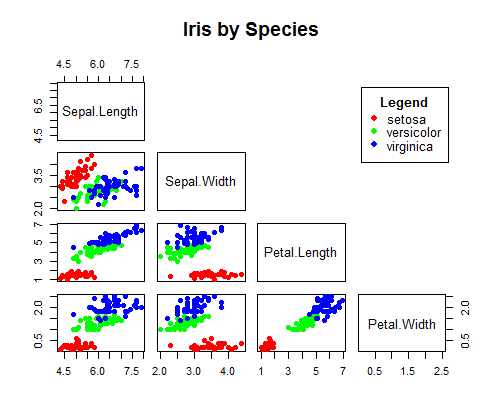Classification in R and Python
18 Feb 2016Data set iris which contains 150 samples with 4 morphological variables in three species of iris is wildly used by data scientists to demonstrate certain machine learning algorithm. I use k-nearest neighbors method[1] to classify the species based on their sepal length and width and petal length and width.
R
1
2
3
4
5
6
7
8
9
10
11
12
13
14
15
16
17
18
19
20
21
22
23
24
25
26
27
28
29
30
31
32
33
34
35
36
37
38
39
40
41
42
43
44
# Load data
data(iris)
# Relationships between the variables (Fig. 1)
pairs(iris[1:4],
col=c("red","green","blue")[iris$Species],
pch=16,
main="Iris by Species",
upper.panel=NULL)
legend(0.75,0.85,
legend=levels(iris$Species),
pch=16,
col=c("red","green","blue"),
cex=0.8,
title=expression(bold("Legend")),
y.intersp=0.6)
# Split the data into training (70%) and test (30%) data set
set.seed(1234)
size <- nrow(iris)
trainIndex <- sample(1:size, 0.7*size)
trainD <- iris[trainIndex,]
testD <- iris[-trainIndex,]
# k-Nearest Neighbor Classification, build model
# on training data and predict on the test data
library(class)
testPred <- knn(train=trainD[,c(1:4)],
test=testD[,c(1:4)],
cl=trainD[,5], # true classifications of the training data
k=3) # I use k=3 here
# Performance
table(testD[,5],testPred)
## testPred
## setosa versicolor virginica
## setosa 11 0 0
## versicolor 0 20 1
## virginica 0 1 12
# Accuracy
sum(diag(table(testD[,5],testPred)))/nrow(testD)
## [1] 0.9555556
 Figure 1 Pairwise relationships between variables.
Figure 1 Pairwise relationships between variables.
Python 2.7
1
2
3
4
5
6
7
8
9
10
11
12
13
14
15
16
17
18
19
20
21
22
23
24
25
26
27
28
29
# Load data
from sklearn import datasets
iris = datasets.load_iris()
label = iris.target
data = iris.data
# Create training and test data set
import random
random.seed(1234)
size = data.shape[0]
trainIndex = random.sample(range(0,size),int(0.7*size))
testIndex = list(set(range(0,size))-set(trainIndex))
trainD = data[trainIndex]
trainL = label[trainIndex]
testD = data[testIndex]
testL = label[testIndex]
# k-Nearest Neighbor Classification
from sklearn.neighbors import KNeighborsClassifier
knn = KNeighborsClassifier(n_neighbors=3)
knn.fit(trainD,trainL)
testPred = knn.predict(testD)
# Performance
sum(testL==testPred)/float(len(testL)) # or knn.score(testD,testL)
## 0.9555555555555556
If you have a variable whose values are quite larger comparing with other variables, you should normalize the variables first.
And try many times to choose the best value for k.